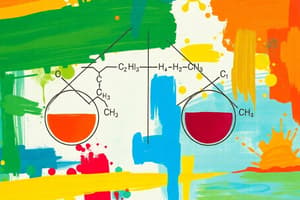Podcast
Questions and Answers
What are the substances involved in a chemical reaction before it occurs?
What are the substances involved in a chemical reaction before it occurs?
- Products
- Coefficients
- Catalysts
- Reactants (correct)
What are the substances produced after the completion of a chemical reaction?
What are the substances produced after the completion of a chemical reaction?
- Coefficients
- Reactants
- Products (correct)
- Catalysts
What is the purpose of balancing a chemical equation?
What is the purpose of balancing a chemical equation?
- To calculate the energy released
- To determine the reaction rate
- To ensure the number of atoms on both sides is equal (correct)
- To identify the reactants and products
Which of the following is an example of a reactant?
Which of the following is an example of a reactant?
Which of the following is an example of a product?
Which of the following is an example of a product?
What is the role of coefficients in a balanced chemical equation?
What is the role of coefficients in a balanced chemical equation?
In a balanced chemical equation, what do stoichiometric coefficients indicate?
In a balanced chemical equation, what do stoichiometric coefficients indicate?
How many moles of methane (CH₄) are involved in the reaction provided in the text?
How many moles of methane (CH₄) are involved in the reaction provided in the text?
What is the purpose of balancing oxidation-reduction equations?
What is the purpose of balancing oxidation-reduction equations?
Why do we add coefficients in chemical equations?
Why do we add coefficients in chemical equations?
When balancing redox equations, what does adding coefficients accomplish?
When balancing redox equations, what does adding coefficients accomplish?
What do coinage metal ions like Fe³⁺ and Cu²⁺ require in balancing redox equations?
What do coinage metal ions like Fe³⁺ and Cu²⁺ require in balancing redox equations?
Study Notes
Balancing Chemical Equations - Reactants, Products, Coefficients
Balancing chemical equations is an essential skill when learning chemistry concepts. At its core, it's about ensuring that the number of atoms on both sides of the equation is equal. This process involves understanding reactants, products, and coefficients in chemical reactions. Let's delve into these aspects.
Understanding Balanced Chemical Equations
A balanced chemical reaction shows the quantity of reactants consumed and products formed when compounds react together. Each element has a specific balance formula that remains constant regardless of how the compound is formed. For example, carbon (C) balances with 6 atoms while hydrogen (H) balances with 1 atom.
Identifying Reactants and Products
Reactants are the substances involved in a chemical reaction before the reaction occurs. They can be simple individual elements like Oxygen (O₂), Carbon Dioxide (CO₂), Water vapor (H₂O), or more complex compounds like Aluminum Chloride (AlCl₃). On the other hand, products are the substances produced after the completion of a chemical reaction. These could also be elements, such as Carbon Monoxide (CO), Sulfur Dioxide (SO₂), or Nitrogen Gas (N₅).
It is important to note that some elements remain unchanged during a reaction and do not appear in either the reactants or products list. Examples include copper (Cu) and magnesium (Mg), which do not form any oxides under standard conditions.
Importance of Coefficients in Chemical Reactions
In a balanced chemical equation, stoichiometric coefficients are used to show the ratio of moles between reactants and products. Stoichiometric coefficients are small numbers placed next to each species in a balanced equation. When summed up across all reactant species, they must equal 1.
For instance, when a molecule of methane (CH₄) reacts with one molecule of oxygen (O₂) to produce one molecule of water (H₂O) and another of carbon dioxide (CO₂), the balanced chemical equation would look like this:
CH₄(g) + O₂(g) → CO₂(g) + H₂O(l)
The coefficient next to CH₄ indicates that one molecule of methane gas takes part in the reaction. Similarly, the coefficients next to O₂, CO₂, and H₂O indicate that one molecule of oxygen gas, carbon dioxide gas, and water liquid, respectively, are formed from the reaction.
Balancing Coinage Metal Ions in Redox Reactions
When dealing with coinage metal ions, such as Fe³⁺, Cu²⁺, Ag¹⁺, Auⁱ⁻, Zn²⁺, Cd²⁺, Pt⁴⁺, and Au³⁺, the first step in balancing redox equations involves identifying the half-reaction for each ion. Once identified, the same half-reaction is added as many times as necessary to balance the equation.
Balancing Oxidation-Reduction Equations
Balancing oxidation-reduction equations involves balancing the number of electrons exchanged during redox reactions. This is done by adding coefficients to the reactants and products until there is an equal number of moles of electrons gained or lost.
For example, consider the reaction between Iron(III) chloride (FeCl₃) and Hydrochloric acid (HCl):
FeCl₃ + 2HCl → FeCl₂ + H₂O
This imbalance arises because two iron atoms lose three electrons each, producing six electrons total. However, four electrons are needed to reduce the hydrogen ion to form water. These four electrons come from the oxygen atom, which gains four electrons in this half-reaction.
By observing the overall Gain-Loss pattern in the balanced equation, the Hydrogen atoms now gain eight electrons (two from Cl⁻ and six from O¹⁺), and the oxygen atom loses four electrons to become H₂O. Thus, the final balanced equation is:
4FeCl₃ + 6HCl → 3FeCl₂ + 3H₂O
Summary
Chemical equilibrium is achieved when the reaction proceeds at an equal rate in both directions, meaning that the concentrations of reactants and products remain constant. Balancing chemical equations is crucial for understanding the stoichiometry of reactions and predicting the amount of products formed. It is an essential skill that allows chemists to predict how reactants will react and how reactants will form products.
Studying That Suits You
Use AI to generate personalized quizzes and flashcards to suit your learning preferences.
Description
Test your knowledge on balancing chemical equations by understanding reactants, products, and coefficients. This quiz covers the importance of balanced chemical reactions, identifying reactants and products, and the role of coefficients in chemical equations.




